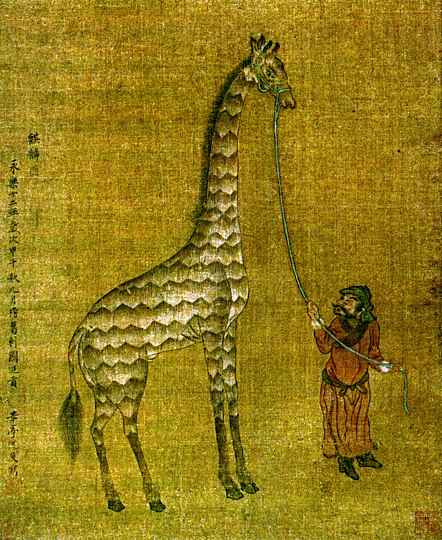Zheng He (Cheng Ho) was a Muslim admiral originally named Ma Ho (the Chinese version of Muhammad). He made seven diplomatic voyages to East Africa as far as Malindi (near Mombasa) between 1405 and 1433. His expeditions followed long established Arab-Chinese trade routes—as evidenced by Sung dynasty porcelains and copper coins excavated at Swahili burial sites. Of possible Mongol-Arab origin, a young Zheng He was captured by the armies of the newly established Ming dynasty, castrated and made a eunuch in the household of Yongle (Yung-lo), located in the imperial capital of Nanjing. Yongle became emperor in 1403, relocated the imperial capital to Beijing, and placed Zheng He in charge of fleets dispatched across the oceans to present gifts and receive tribute on behalf of the emperor. As part of his African itinerary, Zheng He left Aden to Somalia and from Somalia to Zanzibar, observing several Swahili coastal towns. The Chinese chroniclers described the coast as hot and dry and the hardship in which people lived, and yet viewed the coastal people as very pious while mentioning very little about its commerce.
Zheng He returned to China for a festival and did not make the sixth voyage, but African ambassadors returned with him to China in 1419 and stayed for approximately two years until their homeward-bound trip in 1421 through emperor Zhu Di’s orders. Between 1416 and 1423, Mogadishu sent three ambassadorial envoys to China. Emperor Yongle died in 1424. Although his successor was disinterested in foreign voyages and ideas, Zheng He was commissioned by the fifth Ming emperor Xuan Zong to embark upon a seventh and final voyage in 1430. The final voyage returned in 1433 after an attempt to reinvigorate tributary relationships established or maintained during the reign of prior Ming emperors. After the death of Zheng He, China isolated itself from the world for more than 400 years, and its tremendous fleets were burned and the building of ships beyond minimal specifications were forbidden and made punishable by death. Zheng He’s voyages were significant in China’s history and especially during the Ming dynasty.
The official history of the Ming dynasty (Ming shi) only makes room for significant persons and the number of pages accorded to an individual signal their importance. Zhang Tingyu (ca. 1672 – 1755), Qing dynasty politician and senior minister for three emperors, was principal compiler of the Ming shi. Entries in the Ming shi range from a few sentences to a paragraph to several pages; Zheng He was accorded just over two biographical pages, which appear below in English translation. By themselves, the pages say very little about east Africa, and yet they provide important context for understanding the connections made between China and Africa and for probing them further through other sources, including accounts by other Chinese nationals that sailed with Zheng He to east Africa.
Zheng He was from Yunnan Province. He is called the Sanbao Eunuch [“the three-jeweled Grand Ennuch”]. He served initially in the feudatory court of Yan Wang, and due to his military prowess, he was selected as an imperial eunuch.
Emperor Huidi suspected that Emperor Chengzu [whom Huidi had overthrown?] had fled abroad, and he wanted to seek him out. Also, he wanted to show his military might abroad, to demonstrate the wealth and strength of China. In the 6th month of the 3rd year of Yongle [ca. 1405], he ordered Zheng He, and Wang Jinghong [Wang Ching-hung] to go on a comprehensive embassy to the western ocean. There were more than 27,000 officers, troops, and great deal of treasure. They build 62 large ships, 44 zhang [440 to 475 feet] long and 18 zhang [186 to 193 feet] wide.[1] From Liujiahe [Liuchia-kang] in Suzhou they sailed to Fujian Province, and then set sail from Wu-hu-men in Fujian. First they reached Zhancheng [Champa] and from there visited all the tributary nations. They read the imperial edict and gave presents to the local rulers. If they did not submit, they were subdued by armed force. In the 9th month of the 5th year [of Yongle, ca. 1407], Zheng and the others returned, and accompanied by ambassadors from the various nations, he was given an imperial audience. Zheng presented the captive leaders of Jiugang [Palembang]. The Emperor was very pleased and richly rewarded him. Jiugang was formerly known as Sanfojiguo. One of its leaders, Chen Zuyi [Chen Tsi-Yi], committed piracy against merchants. When Zheng presented him the imperial edict, Chen pretended to submit, but secretly plotted rebellion. Zheng soundly defeated him. Chen was captured alive and later executed at the capital.
In the 9th month of the 6th year [of Yongle, ca. 1408], Zheng set out once more, for Xilanshan [Sri Lanka]. The king of the country, Aliekun’aier [Alagakkonara], lured Zheng into the middle of his country and demanded money, while he sent troops to seize Zheng’s ships. Zheng saw through the plot and with the more than two thousand troops he was leading, was able to capture the country's capital, capturing Aliekun’aier along with his family and officials. When the general who was to attack Zheng's ship heard this, he tried to put up a fight but the imperial troops defeated him. In the 6th month of the 9th year [of Yongle, ca. 1411] he presented his captives at court. The Emperor gave them an amnesty with no punishment and released them to return home. At this time, Jiaozhi [Tonkin in Vietnam?] had just been conquered and divided up into counties and districts. The whole area was in turmoil, and more and more people came into the capital.
In the 11th month of the 10th year [Yongle, ca. 1412] Zheng and others set out on an embassy to Sumendala [Sumatra]. Before this, the usurper Suganla [Su-wa-la] had just killed his master and set himself up in his place. He was angry that Zheng would not recognize him and led his troops in a bitter fight with the imperial forces. Zheng fought fiercely and pursued and captured him at Nanboli (Lambri?), along with his wife and children, and returned to the capital in the 9th month of the 13th year [Yongle, ca. 1415]. The Emperor was pleased and liberally rewarded all the officers and men.
In the winter of the 14th year [Yongle, ca. 1416], 19 nations, including Manglajia [Malacca?] and Guli [Cochin, India], presented tribute at court and returned home. Zheng and others were ordered to visit these countries and bestow presents on their rulers. They returned in the seventh month of the 17th year [ca. 1419]. In the spring of the 19th year [ca. 1421], Zheng set out on another embassy, returning in the 8th month of the following year. In the 1st month of the 22nd year [ca. 1424] the chief of Jiugang [Palembang], Shijisun asked to be appointed pacification commissioner, and Zheng took the seal of office to him. When he returned, Emperor Chengzu had already passed away. In the 2nd month of the 1st year of Hongxi [ca. 1425], Emperor Renzong ordered Zheng to use his expeditionary forces to garrison Nanjing. Zheng was the first garrison commander of Nanjing.
In the 6th month of the 5th year of Xuande [ca. 1430], the Emperor noted that, although he had been on the throne several years, the farther tributary states had not yet presented tribute. So he ordered Zheng He and Wang Jinghong to visit Hulumosi (Hormuz) and 16 other states.
Zheng Ho served three Emperors, and in all undertook seven diplomatic voyages. The places he visited were: Zhancheng, Guawa (Java), Zhenla, Jiugang, Xianluo (Thailand), Guli, Manlajia (Malacca?), Boni, Sumendala (Sumatra), Alu, Dagelan, Xiaogelan, Xiyangsuoli, Suoli, Jiayile, Abobadan, Nanwuli, Ganbali, Xilanshan (Sri Lanka), Nanboli, Pengheng (Penang?), Jilandan, Hulumosi (Hormuz), Bila, Liushan, Sunla, Mugudushu (Mogadishu), Malin (Malindi), Lasa, Zufaer, Shaliwanni, Zhubu, Bangala (Bangla or Bengal), Tianfang (Arabia), Lifa, Naguer—over thirty countries in all. He brought back countless priceless treasures, and the expense to China was not excessive. Since Xuande (ca. 1426-1436), there have been many who have come from distant lands to offer tribute, many more than in Yongle (ca. 1403-1425). Zheng grew old and passed away. Since then, all who sailed the seas cited the name of Zheng He to impress the tributary countries. Thus everyone speaks of the Sanbao Eunuch sailing the western ocean as one of the truly important undertakings of the early Ming.
Sources: Zhang Tingyu et al., eds., Mingshi (Beijing: Zhonghua shuju, 1974), 304: 7766-7769; Edward L. Dreyer, Zheng He: China and the Oceans in the Early Ming Dynasty, 1405-1433 (New York: Longman, 2006), first appendix.
[1] zhang is an old Chinese unit of measuring length, equal to 11 feet and 9 inches.


